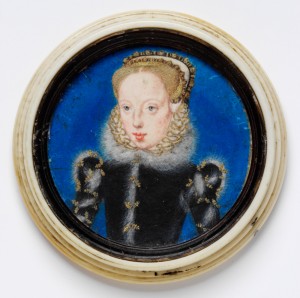
Miniature of Lady Katherine Grey by Levina Teerlinc, V&A Museum
Born on 25th August 1540, Katherine entered into the sixteenth-century just as Henry VIII had married his fifth wife, also named Katherine. This marriage would end in the king executing his second wife for her purported adulterous affairs. The Grey sisters received an excellent education under the tutorage of John Aylmer, with Jane, the eldest Grey daughter, demonstrating her exceptional aptitude for academia during childhood. Jane was fluent in Greek and undertook classical studies with an unwavering dedication and enthusiasm. While de Lisle argues that Katherine was more taken by busying herself with her pets than studious pursuits, she nonetheless excelled and developed into a bright and intelligent woman. When she was eight years old, Katherine was learning Greek under the tutorage of Thomas Harding, a former Regius Professor of Hebrew at the University of Oxford, and progressed successfully. Renowned as the most beautiful of the sisters, Katherine had luscious blonde hair and striking blue eyes. This is evident in a portrait of her from roughly c.1555-1560, when she was between the ages of fifteen and twenty. The miniature portrays a slim, aristocratic young woman in a high-necked dress and ruff, furred and embroidered with golden detailing; a fashionable style during the 1550s. Levina Teerlinc, a Flemish miniaturist, painted this iconic portrait and became a popular artist at the Tudor courts of Henry VIII, Edward VI, Mary I and Elizabeth I.
During the early 1550s, the Grey sisters’ father, Henry, began to exert his influence at the Edwardian court. Evangelicalism was becoming widely accepted among noble-society as a result of the king and his councillors’ further religious reforms; advancing on the already established Henrician policies. The period witnessed the dissolution of religious chantries but suffered from several threatening uprisings, including the Western and Kett’s rebellions, respectively, in 1549. During the early 1550s, the Suffolk family (Henry Grey was created Duke of Suffolk on 11th November 1551, in the same ceremony that elevated John Dudley to the Dukedom of Northumberland) moved to Southwark with the intention of being closer in proximity to the royal court. Protestant men including Suffolk, Northumberland and the Protectorate, Lord Somerset, lobbied the king for support and affection. Indeed, as part of Suffolk’s agenda to place his daughter Jane on the throne, the thirteen-year-old Katherine was betrothed to Henry Herbert, the eldest son of William Herbert, first Earl of Pembroke. While this union would have cemented the Suffolk’s with the well-established Herbert family, it was dissolved once Princess Mary Tudor acceded to the English throne. With the fall of Lady Jane Grey, the Suffolk’s inevitably ceased to exert further influence. The patriarch, Henry, was executed and the duchess became a prisoner of Mary’s at court. Similarly, Lady Katherine was taken into the household of Anne, the dowager duchess of Somerset; a consolation being the shared style of religious practice between the two. While the Greys were a disgraced, heretical family, Lady Katherine was treated with respect at the Marian court and outwardly conformed with the reversion to Catholicism that underpinned the period.
It was during the reign of Elizabeth I that Katherine’s mere existence would pose challenges for her welfare. At the beginning of the Elizabethan period, Lady Katherine’s immediate family, excepting her sister Lady Mary, had died. The latter would later make an unexpected marriage to Thomas Keyes, Elizabeth’s sergeant porter. The union was undoubtedly ill-matched in terms of hierarchical differences. Mary was sadly recognised for her unattractive appearance, once noted as ‘little, crook-backed and very ugly’. In comparison to Mary’s petite figure, Thomas towered over her at an astoundingly tall stature of 6 feet 8 inches. The marriage caused a significant deal of controversy, which resulted in the imprisonment of Keyes and the house arrest of Lady Mary; she would spend almost the remainder of her life living with various families until she formed her own household during the latter end of the 1570s, dying in 1578. In comparison, the 1560s witnessed Lady Katherine become an object of desire among politicians both domestically and abroad in Europe. As stated earlier in the article, she was the direct descendant of Mary Tudor, former Queen of France. As viewed by many critics of Elizabeth’s character, upon her accession to the throne in 1559, Elizabeth was an illegitimate usurper, whose mother was a malevolent, despicable adulterer who ensnared the king of England. According to Henry VIII’s will, Lady Katherine became the heir presumptive to the Tudor throne, which put her in an entirely precarious and somewhat frightening position. There is little evidence to suggest that the young Grey woman had any intention of putting forward her own claim, or challenging Elizabeth’s authority; additionally, she would have needed substantial support in order to promote her cause, which she did not have.
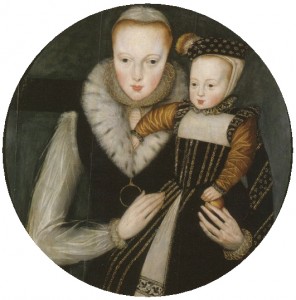
Katherine with her son, Edward
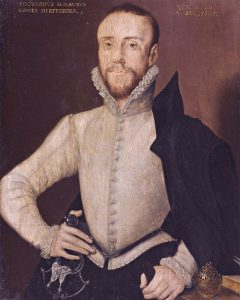
Katherine's husband, Edward Seymour, Earl of Hertford
On her release from the Tower, the countess first stayed with her uncle, Lord John Grey, in Essex. This was a particularly challenging time for her, and she was described as a ‘penitent and soroful soul’, potentially suffering from an eating disorder or self-inflicted starvation. The conditions of her house arrest were strict, and she was essentially confined to the house with few independent liberties. Her next custodian was Sir William Petre, but he died in 1567. Lady Hertford’s last custodian was Owen Hopton of c*ckfield Hall, Yoxford, Suffolk. She would never see her husband again. During her confinement, Lord Hertford did provide rent for his wife, two young children and their staff, however, this did not meet the standards of her station. Queen Elizabeth had to put forward funding in order to meet the meagre contributions of Hertford. He would later remarry, marrying Frances Howard (m.1582-d.1598) and, after her death, Frances Prannell. He died at the advanced age of eighty-one in 1621.
The Countess of Hertford died on 27 January 1568, while in the custody of Owen Hopton, at Yoxford. While initially buried in the estate’s chapel, her grandson later reinterred her remains in the Seymour family tomb at Salisbury Cathedral in the seventeenth century. The tomb is a fantastic, elaborate marble construction consisting of effigies of Lord Hertford, Katherine and their two children. Lady Katherine’s effigy is distinctly raised above that of her husband to demonstrate that both in life and death, she was of a higher rank; being descendent of royalty. To conclude Katherine’s life, and that of her two sisters, it is imperative to remember them as intelligent, steadfast women who held firm in their mortal challenges: Jane’s resolute piety, Katherine’s series of confinements, and Mary’s unconventional marriage.
Photo: Seymour Monument (lower), Salisbury Cathedral
cc-by-sa/2.0 - © Julian P Guffogg - geograph.org.uk/p/3602796
Article by Alex Taylor

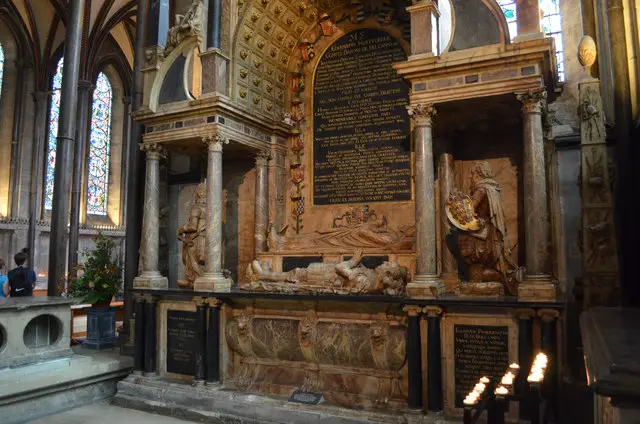
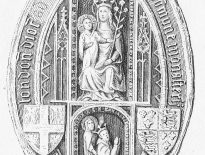
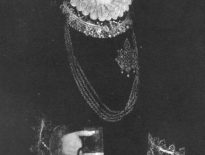
Katherine Grey was regarded by many as a natural successor to Elizabeth, also she was legitimate, whereas Elizabeth was regarded by numerous people as illegitimate. Katherine was next in line after Elizabeth under the wills of Henry Viii and Edward vi and the Third Act of Succession 1544, even though her older sister had been executed as a usurper and traitor in 1554. Elizabeth had a brief close encounter with death in 1562, so in retrospect the marriage of Katherine and the Earl of Hereford seemed even more treacherous. Elizabeth was angry when she found out and the couple were arrested, imprisoned and later separated. The state also “annulled” the marriage , but this might have been dubious.
As the article says, the couple found a way to have intimate relations and they had two sons. After that Elizabeth made certain they were separated, if free, under house arrest and Hereford wasn’t even allowed to see his wife when she was seriously ill. Katherine may have been wrong not to get the Queen’s consent but from the Queen’s point of view her defiance was technically treason. Elizabeth is often criticised as being cruel in her treatment of the two Grey sisters but from her point of view, Katherine was in the wrong. However, in my opinion Elizabeth was cruel to continue to treat her cousin in this manner, especially when she was so ill. I believe Elizabeth was responsible for her premature death.
The case of Mary Grey was even more cruel as she married a man well below her status, just for love and had no interest in the crown whatsoever. He was imprisoned in the Fleet and Mary put in the care of Katherine Willoughby, Duchess of Suffolk and other good families. The grand funeral she was granted at her death by Elizabeth may have been a sign of her regret as well as her cousin’s status.
Why was Henry Grey, Jane and Katherine’s father, Duke of Suffolk? Is that because Frances Brandon was Duchess in her own right? But what about Charles Brandon’s widow? Why were there 2 Duchesses of Suffolk? Thanks, Michelle t
It’s because of the traditional of a male heir. Frances was the heiress after her two brothers died but her husband was created Duke in the right of his wife. There weren’t two Duchesses of Suffolk. Katherine Willoughby, widow of Charles Brandon was now the Dowager or former Duchess, but often used the title.
Hi Michelle,
The title of Duke of Suffolk was inherited from Charles Brandon, Duke of Suffolk, by his sons but they died within 30 minutes of each other from sweating sickness in 1551 so the title in that creation became extinct. Henry Grey was married to Charles Brandon’s daughter, Frances, and he was made Duke of Suffolk, by the third creation of that title just a few months after the boys’ deaths. I believe that he was made Duke “jure uxoris”, meaning that the dukedom was by right of his wife. As RealTudorLady says, Catherine Brandon was the dowager duchess, following her husband’s death, whereas Frances was duchess.
I hope that helps!
Thank you, Real Tudor Lady and Claire. I appreciate it! That explains it. :). Michelle t